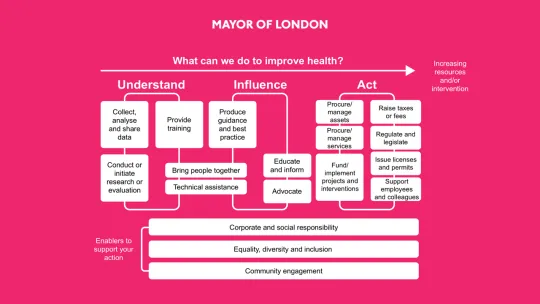
GLA framework of levers for putting health at the heart of policy
The GLA framework of levers for putting health at the heart of policy is a practical tool developed by the GLA Group Public Health Unit that helps us put health at the centre of our work. Use the levers framework to shape the social, cultural, political, economic, commercial and environmental factors that form the building blocks of good health. These include financial/job security, education, green spaces, the built environment, and strong communities.
About the levers framework
The GLA Group Public Health Unit developed the levers framework to help teams across the GLA Group incorporate health considerations in their work. The framework provides a structured approach to help policy leads and policy owners understand what health opportunities or risks their non-health policy can influence.
The framework organises the available mechanisms, or levers, into pillars that cover three different stages of policy or programme development: Understand, Influence and Act.
The levers range from research and data through to guidance and regulations. Putting the levers into action (‘activating the levers’) is underpinned by efforts in corporate social responsibility, equality, diversity and inclusion, and community engagement.
Using the framework
The framework is designed to support all staff to identify the practical opportunities to embed health considerations in their work. It can act as both a training tool and a handy prompt that can be referred to when embarking on programme planning or policy making.
We believe that our framework will also be transferrable or adaptable to other public sector organisations with similar responsibilities and powers, such as local authorities. The framework could also be used as a starting point for organisations to consider what other levers they have at their disposal, which may be unique to their context.
You are welcome to use and apply the framework in your own work but please reference this as: Greater London Authority (2025) framework of levers for putting health at the heart of policy.
The GLA levers framework

The GLA levers framework.
This diagram shows the GLA levers framework and summarises the different mechanisms (levers) that officers can use to promote health in their work, thus showing what we can do to improve health. In the diagram, the levers are organised into three pillars: understand, influence, and act, corresponding to the stages of policy or programme development.
- The first heading is 'Understand', and the levers listed under it are: conduct or initiate research or evaluation; collect, analyse and share relevant health data; and provide training.
- The second heading is 'Influence', and the levers listed under it are: produce guidance and best practice; educate and inform; and advocate. Two levers sit across both 'Understand' and 'Influence': provide technical assistance; and bring people together.
- The third heading is 'Act' and the levers under it are: fund/implement projects and interventions; issue/revoke licenses and permits; regulate and legislate; raise/reduce taxes or fees; and support employees and colleagues.
Underneath the pillars and levers, there are three enablers which underpin and support all of our actions: corporate social responsibility; equality, diversity and inclusion; and community engagement.
The GLA levers framework is organised into three pillars: understand, influence, and act. The activity within each pillar is set out below, with examples.
Understand
These are levers that can be used to increase understanding of health and the factors that can positively or negatively impact it.
Two of the levers could be both tools to increase understanding and influence others:
Influence
As well as the above, officers can influence a person, team or organisation towards health promotion through the following levers:
Act
Through policy and programme delivery, action can be taken to improve health directly or indirectly:
Need a document on this page in an accessible format?
If you use assistive technology (such as a screen reader) and need a version of a PDF or other document on this page in a more accessible format, please get in touch via our online form and tell us which format you need.
It will also help us if you tell us which assistive technology you use. We’ll consider your request and get back to you in 5 working days.